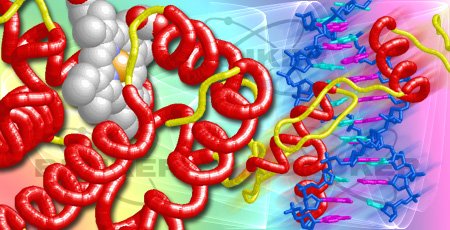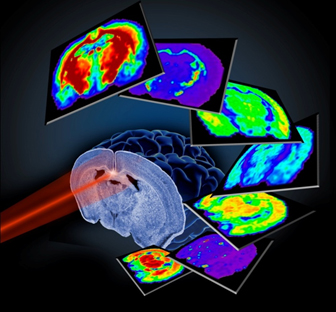History
The mission of the Mass Spectrometry Research Center (MSRC) is to bring state-of-the-art mass spectrometry expertise, methodology, and instrumentation to the research and clinical infrastructure of the Vanderbilt University Medical Center . Dr. Richard Caprioli joined Vanderbilt University in early 1998 to reorganize and further enhance an existing MS facility; the MSRC was established in May of 1998. Dr. David Hachey was recruited later in 1998 to direct the Mass

Spectrometry (small molecule) Core laboratory. Because of the rapid growth in demand for proteomics services the MSRC formally established a separate Proteomics Laboratory that is currently lead by Dr. David Hachey. In September 2003 the MSRC moved into new facilities in Medical Research Building III that provided a more than 2-fold increase in space. The Mass Spectrometry Core Lab currently occupies about 3,800 square feet of laboratory space on the 9th floor of the MRB III that is contiguous with that occupied by the Proteomics Core (3,600 sq ft). Support for the facility comes from service cores affiliated with seven NIH-funded Program Projects and Research Centers , service fees charged to unaffiliated investigators and direct institutional support from Vanderbilt University . The Research and Development laboratories of Dr. Caprioli comprise 5,500 sq ft. of space on the 9th floor of the MRB III and the Tissue Imaging/Serum Biofluids core is enveloped within these three existing service centers.
Protocols & Instrumentation
The MSRC has protocols and instrumentation to form a critical mass in proteomics with established support from the Vanderbilt Ingram Cancer Center , the Molecular Toxicology Center, the Breast SPORE Grant and the Vanderbilt Vision Research Center. The Mass Spectrometry (small molecule) Core provides outstanding collaboration, consultation, and equipment to research investigators throughout the University. The Mass Spectrometry Research and Development Lab continues to provide the Medical Center with cutting-edge instrumentation and methods, including close collaborations with clinicians through translational research. The most recent undertaking of the MSRC is the establishment of the Tissue Profiling/Imaging Laboratory to provide expertise in  molecular analysis of tissues and biological fluids. The mission of this Core is to provide expertise for the analysis of complex proteomes of tissue samples to provide information that can facilitate the detection of disease states, responses to therapy and drug toxicity. Proteome profiling identifies mass spectral patterns derived from multiple proteins in a tissue sample. Proteome imaging can be done by analyzing mass spectral data acquired across a grid within a tissue section. Proteomic patterns can be analyzed with bioinformatics and biostatistical methods to identify sets of diagnostic spectral markers. Identification of the proteins and protein fragments that account for biomarker signals is done in collaboration with the Proteomics Core Laboratory.
molecular analysis of tissues and biological fluids. The mission of this Core is to provide expertise for the analysis of complex proteomes of tissue samples to provide information that can facilitate the detection of disease states, responses to therapy and drug toxicity. Proteome profiling identifies mass spectral patterns derived from multiple proteins in a tissue sample. Proteome imaging can be done by analyzing mass spectral data acquired across a grid within a tissue section. Proteomic patterns can be analyzed with bioinformatics and biostatistical methods to identify sets of diagnostic spectral markers. Identification of the proteins and protein fragments that account for biomarker signals is done in collaboration with the Proteomics Core Laboratory.
Bioinformatics & Collaborations
The amount and complexity of the data generated by the MSRC requires both an active development and support staff to be available to address the needs of the mass spectrometry-based research enterprise at Vanderbilt. The MSRC’s bioinformatics core is actively engaged in both systems and algorithm development to facilitate the analysis and correlation of mass spectral data and clinical information. The core’s support component provides systems support and storage management to members of the facility.
The MSRC conducts collaborative research programs with investigators in nearly every Center and department in the Medical Center as well as many trans-Institutional initiatives in the Departments of Chemistry, Physics & Astronomy, Biological Sciences and Electrical Engineering & Computer Science. Other areas include: Pharmacology, Medicine, Cell & Developmental Biology, Anesthesiology, Psychiatry, Molecular Physiology & Biophysics, Infectious Diseases, Pediatrics, Orthopedics, Hematology/Oncology, Microbiology and  Immunology, Surgical Urology, Otolaryngology, Allergy/Pulmonary, Surgical Sciences, Biochemistry, Radiation Oncology, Clinical Pharmacology, Gastroenterology, Pathology, Nephrology, and Cardiovascular Medicine, Structural Biology, Institute for Molecular Neuroscience, Vanderbilt Ingram Cancer Center (VICC), Digestive Disease Research Center, General Clinical Research Center, Clinical Nutrition Research Unit, and the Molecular Toxicology Research Center. Over 200 investigators currently use the facilities, most as an on-going part of their research programs. In particular, the Proteomics Core facility plays major roles not only in the Cancer Center (VICC), but also in the three funded SPORES (GI, Lung and Breast). It is also a major part of the facilities available to the newly formed Chemical Biology Institute. We also have collaborative arrangements with faculty members at the Meharry Medical College .
Immunology, Surgical Urology, Otolaryngology, Allergy/Pulmonary, Surgical Sciences, Biochemistry, Radiation Oncology, Clinical Pharmacology, Gastroenterology, Pathology, Nephrology, and Cardiovascular Medicine, Structural Biology, Institute for Molecular Neuroscience, Vanderbilt Ingram Cancer Center (VICC), Digestive Disease Research Center, General Clinical Research Center, Clinical Nutrition Research Unit, and the Molecular Toxicology Research Center. Over 200 investigators currently use the facilities, most as an on-going part of their research programs. In particular, the Proteomics Core facility plays major roles not only in the Cancer Center (VICC), but also in the three funded SPORES (GI, Lung and Breast). It is also a major part of the facilities available to the newly formed Chemical Biology Institute. We also have collaborative arrangements with faculty members at the Meharry Medical College .
Industry
In addition, contracts to Vanderbilt University for research in drug metabolism include some of the largest and most prestigious pharmaceutical companies. The basic goal of most of these projects is the measurement of the site of arrival of a drug, a measure of its relative metabolism, and its effect on the protein concentrations at the site of arrival as compared to other areas.
The current configuration of the MSRC, with four core laboratories and a research and development laboratory, currently houses 40 mass spectrometers and has served over 400 users over the past 12 months, making it one of the premier Mass Spectrometry centers in the United States.
